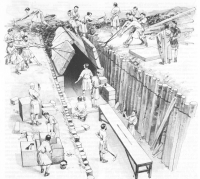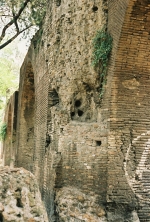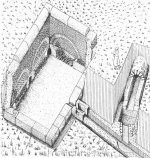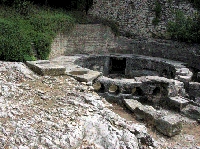



An aqueduct is a channel (illustration A above) or pipe-line (B) to transport water over a greater distance from a water source (C) to its destination (city, farm, industry or mill) where it is distributed (D).
It started with a need for extra water in a city, supplementary to other water sources like a river, rainwater catchment, wells, and/or springs. Then a decision was made by the town council or an individual meacenas, to finance and build an aqueduct by means of a masonry channel or terracotta pipes. A suitable water source must be found, not too far away, at the right level and with water of good quality.
A (military) surveyor started his work with adequate tools, looking for a good course of the aqueduct following the contour lines, with a more or less constant gradient downwards. The construction work of the channel or pipe-line was done - sometimes by the army - preferably in a trench just under the earth surface, with as few works of art like tunnels, bridges, substructions, arcades and siphons, as possible. Here Roman concrete played an important role. The water was conveyed in the channel or pipe-line based on gravity.
When the aqueduct showed up near the city a water distribution system was built by means of primary and secondary castella (basins); the water was brought mainly to public fountains, selected private persons, and public buildings like bath-buildings, and sometimes naumachia, mainly connected by lead pipes.
In some cities wastewater was carried off by means of an open or closed drain like the Cloaca Maxima in Rome to a river nearby.
Only by means of Frontinus we have some knowledge about the way the Romans administered and operated the (11) aqueducts and water supply in the city of Rome. There was a permanent need for maintenance (e.g. removal of incrustation) and repair of the aqueduct. Sometimes complete restoration were needed.
Not only cities were in need of extra supply; water was also needed for other users e.g. irrigation, industry and hydropower (grainmill, mining).
How do we know all this? There still are many archaeological remains, and we possess some written documents (literary sources) like those from Vitruvius and Frontinus, inscriptions, and coins, all related to aqueducts.
Basic literature